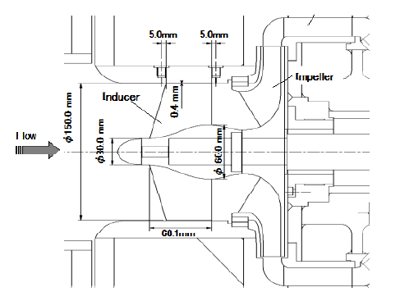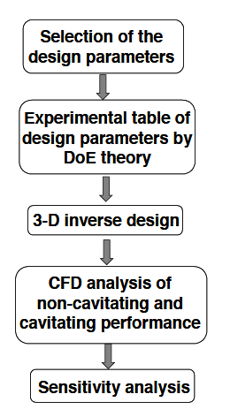In conventional design practice, helical inducers are commonly used for industrial inducer pump applications. Several approaches were tested to improve suction performance or suppress instability related to cavitation phenomena, using a variable lead design or applying a cambered blade design to the inducer geometry.
It has been shower that a backward leading edge sweep suppressed both the development of cavities on the blade suction surface and the occurrence of cavitation instability, such as alternate blade cavitation and rotating cavitation.
Inception and growth of cavitation are closely related to the pressure distribution on the blade surface. Therefore, it is essential to control pressure distribution (and thus blade loading) on the blade surface. They applied the 3D inverse design method developed by Prof. Mehrdad Zangeneh to inducer design and investigated the effects of loading distribution on inducer performance. They shower that zero-incidence with fore-loaded design could suppress inlet recirculation, keeping the required suction performance at the design flow.
Furthermore, they also showed in a study of 3D inverse design of liquid hydrogen rocket pump inducers that zero-incidence design suppressed rotating cavitation in the inducer when operating around design flow. However, in the case of cryogenic pumps for industrial applications, high suction performance and stable pump characteristics are required for operating conditions with high to low flow range. A zero-incidence design may not satisfy the required suction performance requirement at high flow operating range, so it is necessary to investigate design trade-offs between suction performance at high flow and stability at design to low flow conditions. In addition, the effects of blade loading and spanwise work distribution from hub to tip (vortex design) on inducer suction performance and cavitation instability has not yet been clarified.
This paper presents the results of the optimization of cryogenic pump inducer design by means of 3D inverse design approach, Computational Fluid Dynamics (CFD) with cavitation model, and DoE (Design of Experiments) with suction performance and cavitation instability taken into consideration. The effective design parameters on suction performance and cavitation instability were confirmed using sensitivity analysis during the design optimization process. Inducers, which were designed using these parameters and have specific characteristics (stable, unstable), were evaluated experimentally.
Design target
Figure 1 shows the schematic view of pump (Ns= (m, m3/min, min-1) which was composed of inducer, impeller and diffuser. The design target in this study is the inducer of the pump. The design flow coefficient and the head coefficient are 0.132 and 0.135 respectively. The number of blades for the inducer is three.
 Fig. 1. Pump cross section.
Fig. 1. Pump cross section.
Design procedure
Figure 2 shows the optimization process flow chart. The commercial 3D inverse design code from TURBOdesign1 was used to design inducer geometry. Design parameters which are specified in TURBOdesign1. The Design of Experiment (DoE) technique with orthogonal table was applied to arrange the combinations of design parameters to be examined efficiently. Non-cavitating and cavitating performance of designed geometries with arranged design parameters were analyzed by commercial Navier-Stokes code Ansys CFX. Sensitivity analysis was performance in order to identify the impact of each design parameter against the objective functions.
 Fig. 2. Flow chart of the optimization process.
Fig. 2. Flow chart of the optimization process.
To discover the procedure and the results of this design optimization of three-bladed pump inducer, request your copy below.
Mehrdad Zangeneh
Mehrdad Zangeneh is Founder and Managing Director of Advanced Design Technology and professor of Thermofluids at University College London.
View All Articles






Share This Post